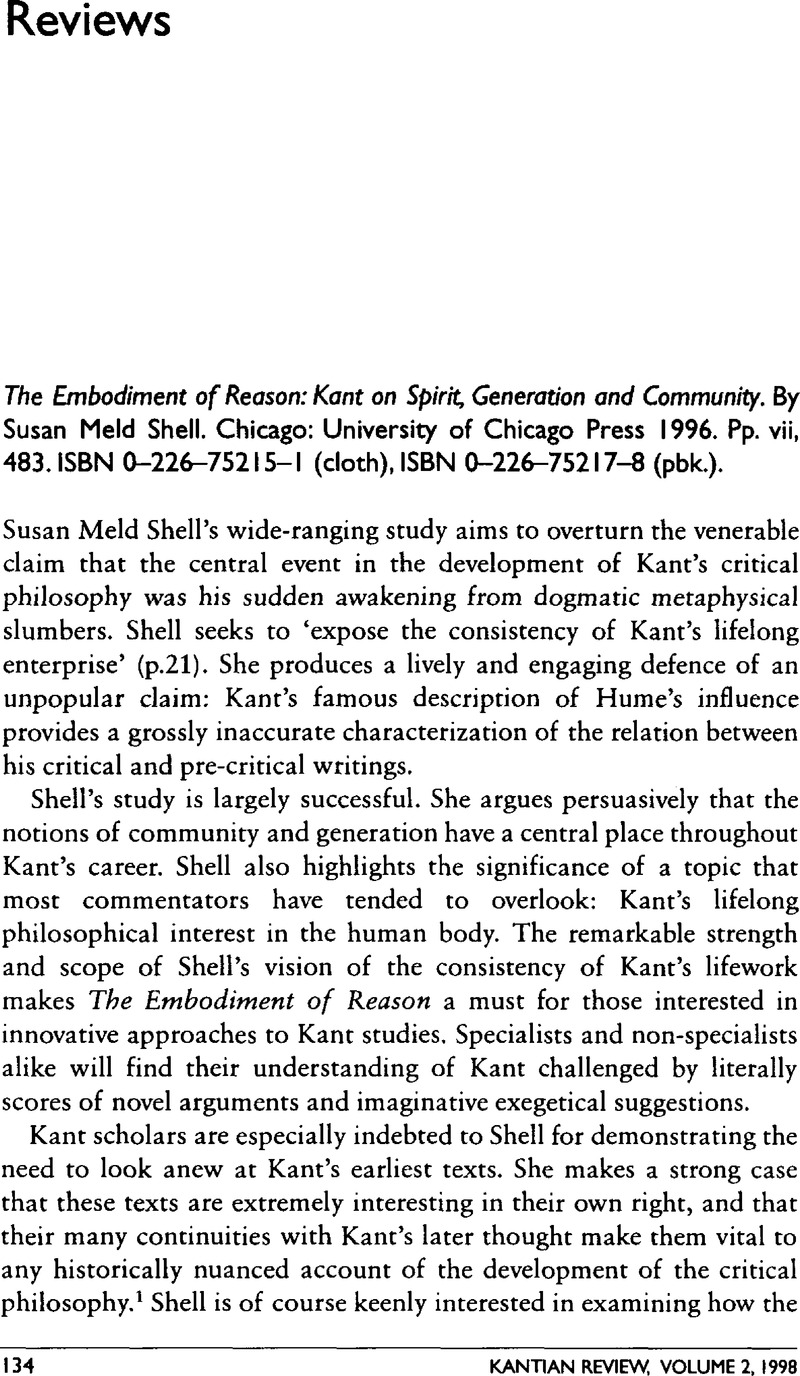No CrossRef data available.
Published online by Cambridge University Press: 27 September 2011

1 A classic study of the close relation between the pre-critical and critical writings is Heinz Heimsoeth's 1924 essay ‘Metaphysical Motives in the Development of Critical Idealism’, printed in Gram, Moltke S. (ed.), Kant: Disputed Questions (Chicago: Quadrangle Books, 1967).Google Scholar
2 A full translation of Living Forces is forthcoming in the Cambridge edition of the works of Immanuel Kant (Cambridge: Cambridge University Press, 1992–). Friedman, Michael discusses this work in Kant and the Exact Sciences (Cambridge, MA: Harvard University Press, 1992).Google Scholar Extensive discussions of Living Forces are also found in the first volume of Adickes's, ErichKant als Naturforscher (Berlin: De Gruyter, 1924)CrossRefGoogle Scholar, in Tonelli's, GiorgioElementi metodologici e metafisici in Kant dal 1745 al 1768 (Turin: Edizioni di ‘Filosofia’, 1959)Google Scholar, and in Vuillemin's, JulesPhysique et métaphysique kantiennes (Paris: Presses Universitaires de France, 1955).Google Scholar
3 See Dreams of a Spirit-Seer (especially Akademie edition 2: 355–6) and Kant's celebrated letter to Charlotte von Knoblauch dated 10 August 1763. Kant considered several stories about Swedenborg's extraordinary powers, among them the story of the fire and another involving Swedenborg's communion with spirits at the behest of the Queen of Sweden, to have been well-documented by reliable witnesses.
4 Laywine, Alison, Kant's Early Metaphysics and the Origins of Kant's Critical Philosophy (Atascadero, CA: Ridgeview Publishing Company, 1993).Google Scholar Shell notes that she received Laywine's study too late to comment on it in The Embodiment of Reason. Laywine's study presents a detailed account of Kant's metaphysical views of the mid-1750s and early 1760s. She argues that the breakdown of these views in the 1760s led Kant to develop crucial critical insights about the distinction between sensibility and understanding.
5 For an example of the traditional attitude, see David Walford's preface to his volume of the Cambridge edition of the works of Immanuel Kant. Walford considers the Universal Natural History to be an important scientific work, but he thinks it ineligible for inclusion in a volume devoted to Kant's theoretical philosophy. See Kant, Immanuel: Theoretical Philosophy, 1755–1770 (Cambridge: Cambridge University Press, 1992), p. xv.Google Scholar
6 Watkins, Eric, ‘The development of physical influx in early eighteenth century Germany: Gottsched, Knutzen, and Crusius’, Review of Metaphysics, 49 (December 1995), 295–339.Google ScholarWatkins, , ‘Kant's Theory of Physical Influx’, Archiv für Geschichte der Philosophie, 77 (1995), 285–324.CrossRefGoogle Scholar Watkins, ‘From pre-established harmony to physical influx: Leibniz's reception in eighteenth century Germany’, forthcoming in Garber, Dániel and Ariew, Roger (eds.), Leibniz and Science. The classic study of these issues in English is Irving Polonoff's Force, Cosmos, Monads and Other Themes of Kant's Early Thought (Bonn: Bouvier Verlag Herbert Grundmann, 1973).Google Scholar
7 Gerd Buchdahl also stresses the importance of Kant's early discussions of lawfulness and systematicity in his Metaphysics and the Philosophy of Science: The Classical Origins Descartes to Kant (Oxford: Basil Blackwell, 1969).Google Scholar Buchdahl's work represents a notable precedent for considering the Universal Natural History an important philosophical work.
8 For this, see my dissertation ‘Kant and the Human Body’, University of California at Berkeley, forthcoming. Although Lome Falkenstein does not examine the history of this issue in Kant's early works, he provides a detailed account of Kant's views on the relation between the human body and cognition as it relates to the transcendental aesthetic in the Critique of Pure Reason. See especially the third chapter of his Kant's Intuitionism (Toronto: University of Toronto Press, 1995).Google Scholar
9 Beiser, Frederick C., Enlightenment, Revolution, and Romanticism: The Genesis of Modern German Political Thought (Cambridge, MA: Harvard University Press, 1992).CrossRefGoogle Scholar
10 Schott, Robin May, Cognition and Eros: A Critique of the Kantian Paradigm (Boston, MA: Beacon Press, 1988).Google ScholarCutrofello, Andrew, Discipline and Critique: Kant, Poststructuralism, and the Problem of Resistance (Albany, NY: State University of New York Press, 1994).Google Scholar